
English Instructional Plan – Grades 9-12
- Subject:
- English
- Writing
- Material Type:
- Lesson Plan
- Author:
- VDOE Project Team
- Date Added:
- 04/22/2022

English Instructional Plan – Grades 9-12

English Instructional Plan- Comparative Analysis of Two Texts

This CS Student Journal uses Essential Questions from the CS SOL Curriculum Framework for Grade 5.

English Instructional Plan – Crowd Sourcing False Premise Analysis and Rewriting for Clarity

English Instructional Plan – Crowd-Sourcing Thesis Writing
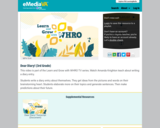
This video is part of the Learn and Grow with WHRO TV series. Watch Amanda Knighton teach about writing a diary entry.

This is the final part of an extended lesson on decomposition. Students will create a word problem to decompose and then use GameChangineer to create a mini game that is reflective of the word problem and its solution. Students will be using the plan, design, and review process thourhgout their creations. A rubric and self reflection tool for the final products are included. Activities are low prep with modifications included, but do require organized planning to implement effectively. If you have not done a lesson on decomposition, it is suggested you use Part 1 to help student's gain the necessary understandings of the processes used in this lesson. If you have not done a lesson on writing commands and using GameChangineer, it is suggested you use Part 2 before implementing this independent activity.

Students describe their phone or other frequently used favorite technology item. They tell what it looks like, how often they use it, and what they use it for.

English Instructional Plan – Descriptive Writing for Grades K and 1

This lesson helps students realize the impact of writing with effective description.

English Instructional Plan-Developing Fluency 6-8

English Instructional Plan Developing Thesis Statements 6-8

English Instructional Plan- The Elements of an Effective Resume

This is a long-term project that requires students to use essays they write for class to compile a portfolio. The portfolio requires the students to revise and review work they have already been graded on in order to continue to improve their writing skills.
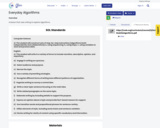
A lesson that uses writing to explore algorithms.
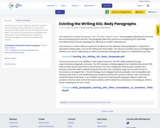
This resource is a quick reference guide for students as they develop body paragraphs in response to persuasive writing tasks, such as the Writing SOL Short Paper. The resource includes various strategies that students can use for elaborating on ideas and exemplar paragraphs based on a released SOL prompt.

English Instructional Plan – Expository Writing for Grades 4 and 5

English Instructional Plan – Expository Writing: Grades 2-3
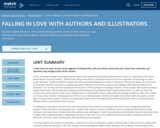
In this unit students explore and experience the works of five award winning authors and illustrators; Grace Lin, Yuyi Morales, John Parra, Monica Brown and Jerry Pinkney. Students learn about each author or illustrator's life and his or her inspiration for becoming an author and/or illustrator. Students will think critically and make connections between the author or illustrator's life and the stories he or she writes or illustrates, and how each author's unique personality is reflected in the words or pictures. By studying a wide variety of authors and illustrators, it is our hope that the foundations will be set for a life-long interest in reading and books. Author studies help students develop a deeper attachment to books while also noticing and identifying the many different ways in which authors write. It is also our hope that students will use the authors in this unit as writing mentors, mimicking the author's style while also building confidence in their own writing and unique ideas. Another underlying focus of this unit is on helping students identify and explain why certain books win awards, and the types of awards that are given. In future units and grades students will read additional award winning stories written or illustrated by the different authors and illustrators from the unit.
In reading this unit builds on the first three units and assumes that students are inquisitive consumers of text, asking and answering questions while listening to and enjoying a story. Students will continue to work on retelling a story, including key details about setting, characters and major events. Students will also continue to be challenged to'read' the illustrations and think about how the illustrations help a reader better understand what is happening in the story. At the end of this unit, students should also be able to clearly articulate and define the role of the author and illustrator and why they are both important.
In writing students will continue to write daily in response to the text. At this point, students should be able to draw or write an answer that correctly answers the question. In this unit, students will be challenged to details to their writing to show a deeper understanding of the question. Over the course of the unit students will also write opinion pieces about which book by the author or illustrator was their favorite and why.
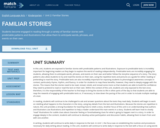
In this unit, students are exposed to familiar stories with predictable patterns and illustrations. Exposure to predictable texts is incredibly important for beginning readers as they begin to explore the world of reading independently. Predictable texts are incredibly engaging for students, allowing them to anticipate words, phrases, and events on their own and better follow the storyline sequence of a story. The story patterns also allow students to try and read the stories on their own, using the repetitive texts and pictures as a guide for either reading or pretending to read the story. Predictable texts are also incredibly important for exposing students to phonological awareness concepts in context, particularly rhyme, rhythm, and fluency. In order for students to reap these benefits, however, they need to deeply engage with the stories. This means that the stories need to be read, reread, retold, and reread some more so that students are able to build the confidence they need to pretend to read or read the text on their own. Within the context of this unit, students are only exposed to the text once; therefore, it is the responsibility of the teacher to find ways to bring the stories to life in other parts of the day so that students are able to reap the rewards of engaging with predictable texts or, if necessary, to slow down the pacing of the unit in order to include multiple readings of a text.
In reading, students will continue to be challenged to ask and answer questions about the texts they read daily. Students will begin to work on retelling what happens to the characters in the story, using key details from the text and illustrations. Because the stories are repetitive in nature, this unit provides a strong foundation for teaching how to retell a story. Another focus of this unit is on understanding how authors and illustrators use illustrations and repetition to help a reader understand the main events in a story. Students will learn how to closely'read' illustrations for subtle clues about character feeling or foreshadowing clues for what is going to happen next in a story. In order to engage deeply in the content, students will continue to develop active participation and discussion habits, allowing them to learn from and with one another.
In writing, students will continue to write daily in response to the text. In Unit 1, the focus was on establishing the routines and procedures necessary for daily writing about reading. In this unit, students will continue to write daily in response to the text with a focus on using words and pictures to correctly answer the question.